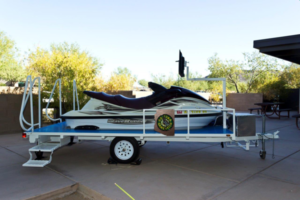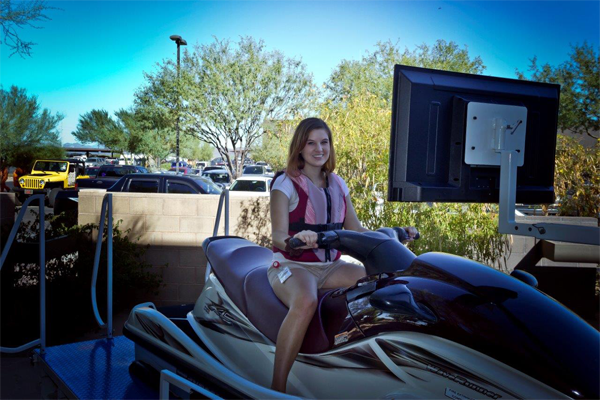State Agencies Collaborate to Better Serve the Public
Arizona Game and Fish Department and Arizona Correctional Industries Make Beautiful Music Together
As a land-locked, mostly desert state, many assume that water safety was not a pressing an issue for Arizona residents. Yet, because residents and visitors have access to multiple lakes throughout the state, the Arizona Game and Fish Department works to teach boaters, personal watercraft users and the public the importance of having a fun, safe time on the water.
Promoting such safety messages is important for the state agency, which is funded primarily through fishing and hunting permit fees. Providing this critical safety information falls to the Department’s Education Branch, which is dedicated to teaching residents on safe practices in their gaming and sporting use of state lands and facilities.
“We understand that when you’re out enjoying your Saturday fishing, jet skiing or boating on one of our rivers or lakes you want to relax and forget about all the hassles of rules and regulations,” said Kim Jackson, AZGFD Boating and Off-Highway Vehicle Safety Education Program manager. “Water safety is critically important but we just want to make sure everyone has fun and gets home safely at the end of the day.” That was the goal with the Department’s new Life Jacket Loaner Stations, which were recently installed at Lake Pleasant, Lake Havasu and Lake Mohave. The Life Jacket Loaner Program is made possible through a grant provided by the US Coast Guard, which finances the infrastructure and life jackets. However, with help from a local nonprofit, the Ryan Thomas Foundation has donated nearly 200 life jackets to the Life Jacket Loaner Program.
 This Arizona non-profit was begun by the family of Ryan Thomas in his memory after he tragically drowned on Saguaro Lake in 2008 at the age of 21. Despite the fact that he was an excellent swimmer, athlete and boater, Ryan fell off his boat 20 feet from the dock and drowned. He was not wearing a life jacket.
This Arizona non-profit was begun by the family of Ryan Thomas in his memory after he tragically drowned on Saguaro Lake in 2008 at the age of 21. Despite the fact that he was an excellent swimmer, athlete and boater, Ryan fell off his boat 20 feet from the dock and drowned. He was not wearing a life jacket.
“The life jacket program is modeled after one in Alaska, where it has 627 stations that have been placed in 249 communities around the state, hosted by many different agencies, organizations, and individuals. At least 24 Alaskan children are known to have survived a near-drowning accident because of borrowing one of these jackets,” Kim said “We figured that with all the activity on our waterways, it just makes sense to do a program like that here in Arizona.”
The Department partnered with ACI to create the life jacket kiosks. “We were already familiar with their capabilities as they have been providing all kinds of outdoor structures for the department for years,” Kim said.
While visiting a State Park or recreational area, residents will see identifying and directional signs, kiosks, benches, shade structures, and many other standard and one-of-a-kind metal fabrications that the Game and Fish Department has purchased from the Arizona Correctional Industries (ACI) over the last 10 years.
“We knew what we wanted,” Kim continued, “because we’d seen several life jacket stations from programs in Oregon and Idaho. But unlike those programs, where the kiosks are made out of wood and require constant maintenance, we wanted structures that would last, require very little maintenance (beyond keeping the supply of life jackets stocked) and could be easily relocated — if necessary.”

“Because we’ve worked with Erika and the guys in the Florence shop before we knew they would work with us to design exactly what we need.” Erika Seborg is the ACI account executive for the Game and Fish Department. She works very closely with the managers and draftsman in the ACI industrial yard in Florence to design and manufacture custom products for her customers. Metal shop manager Jim Robideau will often make the drive up from Florence to the Game and Fish facility on Carefree Highway in north Phoenix to discuss requirements and suggest design options.
“The first design was very heavy and bulky and we knew that we’d have a difficult time installing it,” Kim further explained, “so they went back to the drawing board and came up with a design they could deliver in two parts that were each light enough for a couple of us to easily bolt into place.”
ACI gave detailed instructions on the placement of the footers, the size and precise location of the bolts. Department staff could then dig the footers, pour the concrete foundations ahead of time and know that as the kiosk was loaded off the delivery truck it would fit perfectly in place.
The new, lighter roof design makes it easy to set it in place and bolt it down. “We don’t need to call in expensive contractors to do the installations for us, which means we have more resources to install more of the kiosks, which we plan on doing in the coming months,” Kim said.
Today there are two stations at boat launch sites on Lake Pleasant and one each at Lake Havasu and Lake Mojave. Additional stations are planned for other lakes around the state in the coming months.
Update! Since this story first appeared, more than 20 life jacket stations have been manufactured and installed around the state. And dozens are in the process of being built.
But that is just one aspect of the department’s commitment to boating safety.
As their fiscal year budgeting was winding down, Kim and her team again came to ACI with a request for something outside the box. The Department had been transporting a Jet Ski (without an engine) around to various camps and shows to demonstrate safe operation techniques. But they thought if they could permanently affix the watercraft to its trailer, , they could create a Jet Ski simulator to better illustrate how to properly use the machine.
 Again, the ACI production team came through, designing and building a true Jet Ski simulator atop a trailer. It features three pull out stairways, movable handrails all around, a built in storage area, a wide, solid platform on each side of the Jet Ski and a mount over the front to place a TV monitor to view simulated boating scenarios while steering the jet ski.
Again, the ACI production team came through, designing and building a true Jet Ski simulator atop a trailer. It features three pull out stairways, movable handrails all around, a built in storage area, a wide, solid platform on each side of the Jet Ski and a mount over the front to place a TV monitor to view simulated boating scenarios while steering the jet ski.
“When you see what we gave them: basically a bare bones trailer, an empty jet ski and a picture of rudimentary simulator from the Idaho parks department,” Kim exclaims, “it’s unbelievable what Erika and the guys from Florence came up with for us. It’s much more than we ever imagined! It’s perfect. We’ve tried out the monitor and everything works perfectly.”
The simulator will be used at shows and events beginning in January, before the next water sporting season. It will also be part of the Department’s Boating Safety Education program, conducted by coordinator Josh Hoffman. He is working with educators from around the state to create a curriculum on water safety for fifth graders that includes important science and math concepts. The sessions will be presented in the fall and spring.
“We want to get kids engaged at an early age,” Josh explains, “get them thinking about safety from the beginning so that by the time they’re old enough to be out there on the lakes by themselves they’ll automatically be putting on that life vest and operating their boats and jet skis properly.”
“By bringing in the science and math aspects of water safety into the lessons we’re showing them why it just makes sense to do things the right way. This might be a new way to get kids interested in STEM curriculum, seeing how it helps them have fun — safely!” he added.
As they continue to roll out these water safety programs throughout the state, Kim and Josh are already talking with ACI’s metal shop draftsman about creating an OHV simulator to help them teach adults and children to ride safely and responsibly. Given their track record, the ACI team will no doubt deliver another great product to the Game and Fish Department in the near future.

